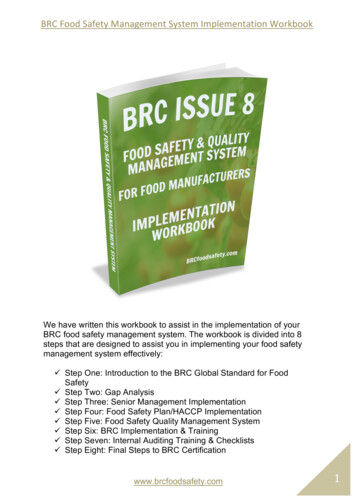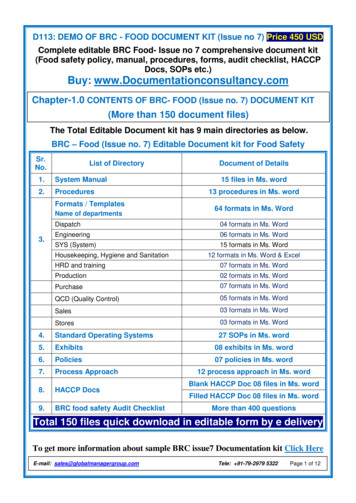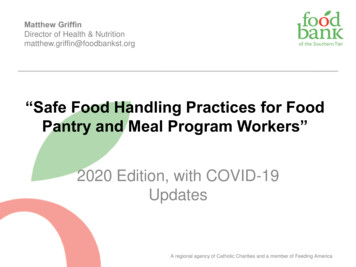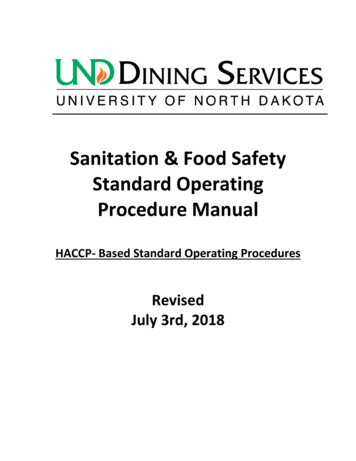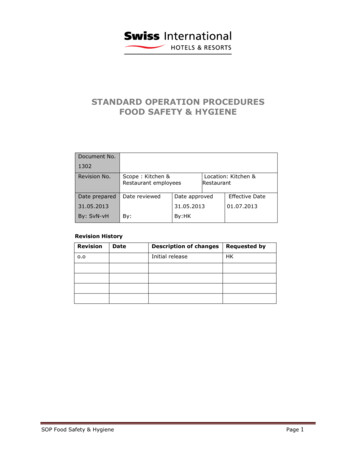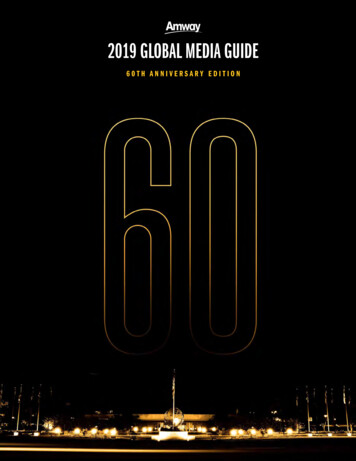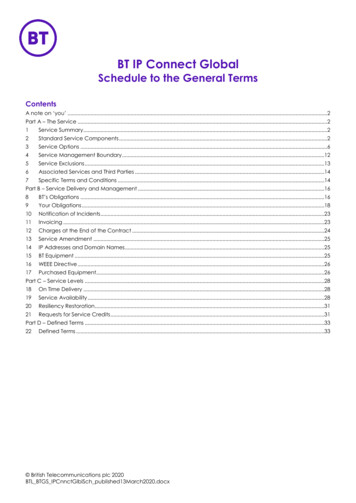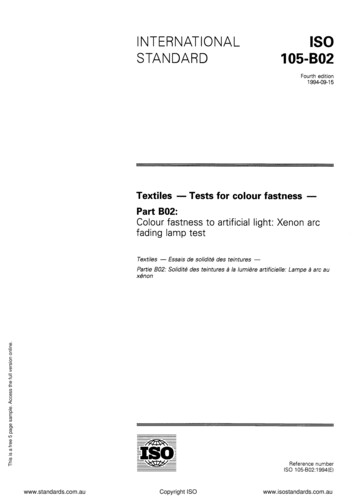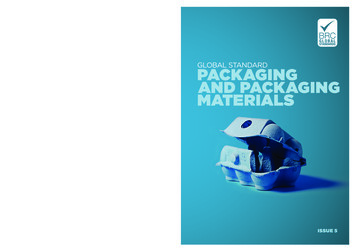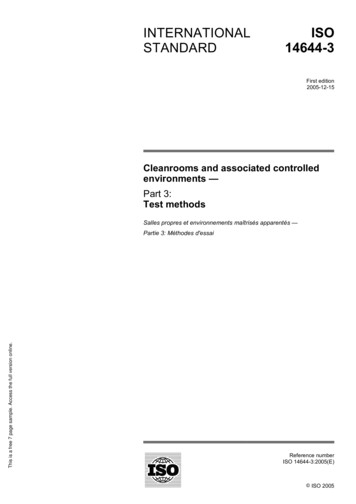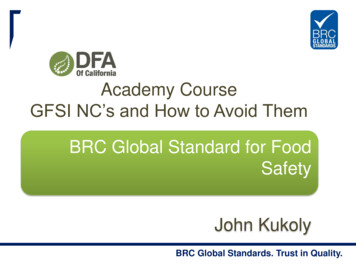
Transcription
Academy CourseGFSI NC’s and How to Avoid ThemBRC Global Standard for FoodSafetyJohn KukolyBRC Global Standards. Trust in Quality.
BRC UpdateOver 22,000 certificated sites worldwide 18,000 in the Food Standard Certificates issued in 118 different countries2014 Launches January: Auditor Category examsFebruary: Agents and Brokers StandardOctober : BRC Participate Launch2014 – 1000 sites go unannounced audit planJanuary 2015 – Food 7 releasedBRC Global Standards. Trust in Quality.
BRC Global StandardsGFSIGFSIGFSIBRC Global Standards. Trust in Quality.
Changes to the Audit ProtocolBRC Global Standards. Trust in Quality.
Scope/Exclusions from scopeObjective Ensure clarity for customers of the site Protection of the BRC BrandChange Exclusions limited to the following conditions the excluded products can be clearly differentiated fromproducts within scopeAND the products are produced in a physically segregated areaof the factory. Logo use not permitted where exclusions presentBRC Global Standards. Trust in Quality.
GradingObjective Encourage differentiation and improvement Relieve pressure on reporting issuesChange New AA top grade for 5 minor NCs A grade remains unchanged / 10 minors B and C grades redistributed over B,C anda new Grade DBRC Global Standards. Trust in Quality.
Changes to the Audit RequirementsBRC Global Standards. Trust in Quality.
Supplier ApprovalObjective Update requirements to cover packaging Ensure sufficiently rigorous processes are inoperationChange Fundamental requirement All 3 clauses revised New requirement for traceabilityBRC Global Standards. Trust in Quality.
3.5.1Management of suppliers of raw materials and packaging3.5.1.1 The company shall undertake a documented risk assessment of each raw material or group of rawmaterials including packaging to identify potential risks to product safety, legality and quality. Thisshall take into account the potential for: Allergen contaminationForeign-body risksMicrobiological contaminationChemical contaminationSubstitution or fraud (see clause 5.4.2)Consideration shall also be given to the significance of a raw material to the quality of the finalproduct.The risk assessment shall form the basis for the raw material acceptance and testing procedureand for the processes adopted for supplier approval and monitoring. The risk assessments shall bereviewed at least annually.BRC Global Standards. Trust in Quality.
3.5.1Management of suppliers of raw materials and packaging3.5.1.2 The company shall have a documented supplier approval and ongoing monitoring procedure toensure that all suppliers of raw materials, including packaging, effectively manage risks to rawmaterial quality and safety and are operating effective traceability processes. The approval andmonitoring procedure shall be based on risk and include one or a combination of: Certification (e.g. to BRC Global Standards or other GFSI-recognised scheme)Supplier audits, with a scope to include product safety, traceability, HACCP review and goodmanufacturing practices, undertaken by an experienced and demonstrably competent productsafety auditor.or, for suppliers assessed as low risk only, supplier questionnaires.Where approval is based on questionnaires, these shall be reissued at least every 3 years andsuppliers be required to notify the site of any significant changes in the interim.The site shall have an up-to-date list of approved suppliers.BRC Global Standards. Trust in Quality.
3.5.1Management of suppliers of raw materials and packaging3.5.1.4 The procedures shall define how exceptions to the supplier approval processes inclause 3.5.1.2 are handled (e.g. where raw material suppliers are prescribed by acustomer) or where information for effective supplier approval is not available (e.g.bulk agricultural commodity products) and instead product testing is used to verifyproduct quality and safety.When a site produces customer-branded product the relevant exceptions shall beidentified to the customer.BRC Global Standards. Trust in Quality.
TraceabilityObjective Meet concerns regarding supply chain traceability Visibility where agents and brokers are usedChange 2 new clauses: Greater assurance of supplier traceability Agents and brokers accountabilityBRC Global Standards. Trust in Quality.
Traceability – Revised clauses3.9Traceability3.9.3The company shall verify that its suppliers of raw materials have an effective traceability system.Where a supplier has been approved based on a questionnaire, instead of certification or audit,verification of the supplier’s traceability system shall be carried out on first approval and then atleast every 3 years. This may be achieved by a traceability test. Where a raw material is receiveddirectly from a farm or fish farm, further verification of the farms traceability system is notmandatory.3.5.1Management of suppliers of raw materials and packaging3.5.1.3 Where raw materials are purchased from agents or brokers, the site shall know the identity of thelast manufacturer or packer, or for bulk commodity products the consolidation place of the rawmaterial.Information to enable the approval of the manufacturer, packer or consolidator, as in clause3.5.1.2, shall be obtained from the agent/broker or directly from the supplier, unless theagent/broker is themselves certificated to the BRC Global Standard for Agents and Brokers.BRC Global Standards. Trust in Quality.
Labelling and Pack ControlObjective Address the most common issue resulting in productrecalls and withdrawals.Change New Fundamental section: Labelling and Pack control New section: Product Labelling Detailed requirements to manage product changeover Sample label verification within vertical traceabilityauditBRC Global Standards. Trust in Quality.
5.2Product Labelling5.2.1 All products shall be labelled to meet legal requirements for the designated country of use and shallinclude information to allow the safe handling, display, storage, preparation and use of the productwithin the food supply chain or by the customer. There shall be a process to verify that ingredient andallergen labelling is correct based on the product recipe and ingredient specifications.5.2.2 There shall be effective processes in place to ensure that labelling information is reviewed wheneverchanges occur to: the product reciperaw materialsthe supplier of raw materialsthe country of origin of raw materialslegislation5.2.3 Where a product is designed to enable a claim to be made to satisfy a consumer group (e.g. a nutritionclaim, reduced sugar), the company shall ensure that the product formulation and production processis fully validated to meet the stated claim.5.2.4 Where the label information is the responsibility of a customer or a nominated third party the companyshall provide: information to enable the label to be accurately createdinformation whenever a change occurs which may affect the label informationBRC Global Standards. Trust in Quality.
6.2Labelling and Pack control6.2.1There shall be a formal process for the allocation of packaging materials to packing lines and control in the packing area whichensures that only the packaging for immediate use is available at the packaging machines.Where off line coding or printing of packaging materials occur, checks shall be in place that only correctly printed material is availableat the packaging machines.6.2.2Documented checks of the production line shall be carried out before commencing production and following changes of product. Theseshall ensure that lines have been suitably cleaned and are ready for production. Documented checks shall be carried out at productchanges to ensure all products and packaging from the previous production have been removed from the line before changing to thenext production.6.2.3Documented procedures shall be in place to ensure that products are packed into the correct packaging and correctly labelled. Theseshall include checks: at the start of packing, during the packaging run, when changing batches of packaging materials at the end of each production run.The checks shall also include verification of any printing carried out at the packing stage including, as appropriate: 6.2.5date codingbatch codingquantity indicationpricing informationbar codingcountry of originWhere on line vision equipment is used to check product labels and printing, procedures shall be in place to ensure that the system iscorrectly set up and capable of alerting or rejecting product when packaging information is out of specification.BRC Global Standards. Trust in Quality.
AuthenticityObjective Encourage development of systems to avoid purchase offraudulent products Response to requirements of EU Report 2013/2091Change 3 new clauses: Access to information to inform risk assessments Vulnerability assessment of raw materials Introduction of risk based testing or assurance tomitigate risk.BRC Global Standards. Trust in Quality.
5.4Product Authenticity, Claims and Chain of CustodyStatementof IntentSystems shall be in place to minimise the risk of purchasing fraudulent or adulterated raw materialsand ensure that all product descriptions and claims are legal accurate and verified.5.4.1The company shall have processes in place to access information on historical and developingthreats to the supply chain which may present a risk of adulteration or substitution of raw materialsSuch information may come from: 5.4.2trade associationsgovernment sourcesprivate resource centres.A documented vulnerability assessment shall be carried out of all food raw materials or groups ofraw materials to assess the potential risk of adulteration or substitution. This shall take into account historical evidence of substitution or adulterationeconomic factors which may make adulteration or substitution more attractiveease of access to raw materials through the supply chainsophistication of routine testing to identify adulterants.Nature of the raw materialThe vulnerability assessment shall be kept under review to reflect changing economiccircumstances and market intelligence which may alter the potential risk. It shall be formallyreviewed annually.5.4.3Where raw materials are identified as being at particular risk of adulteration or substitutionappropriate assurance and/or testing processes shall be in place to reduce the risk.BRC Global Standards. Trust in Quality.
Ambient High CareDefinition Environment designed to minimize product contamination A raw material is prone to contamination with avegetative pathogen Production process includes a process step whichremoves or reduces the pathogen Finished products are stored at ambient temperatures Final product is ready to eat or heat Finished products are such that vegetative pathogenscould survive and grow in normal use, subsequentlycausing food poisoning, or are of a nature that enablesfood poisoning to result from a very low level ofcontaminationBRC Global Standards. Trust in Quality.
Ambient High Care4.3Layout, Product Flow and Segregation4.3.7Where ambient high care areas are required a documented risk assessment shall becompleted to determine the risk of cross-contamination with pathogens. The riskassessment shall take into account the potential sources of microbiological contaminationand include: the raw materials and productsflow of raw materials, products, equipment, personnel and wasteairflow and air qualityutilities (including drains)Effective processes shall be in place to protect the final product from this contamination.These processes may include segregation, management of process flow or other controls.BRC Global Standards. Trust in Quality.
Changes to the Standard &ProtocolMinor changes to existing requirementsUnannounced audits remain voluntarybut extended to be accessible to allEnrolment program broken into 3 tieraudit renamed BRC Global MarketsBRC Participatewww.brcparticipate.comBRC Global Standards. Trust in Quality.
BRC Global Standards. Trust in Quality.
US performance by CategoryGrade & minors per ryfoods prepared2Rawpoultry5534Cooked Prepared Can, Jars Dairy, Raw redmeat fruit, vegliquid egg meatReadyMealsTop 10 categories, new & renewal 2014 auditsBRC Global Standards. Trust in Quality.
US VS Rest Of The WorldMinors per audit98876MPA65545565654434321524443USAROTW20Top 10 US categories, new & renewal 2014 auditsBRC Global Standards. Trust in Quality.
US VS Rest Of The WorldA Grade 7469808482USAROTW20100Top 10 US categories, new & renewal 2014 auditsBRC Global Standards. Trust in Quality.
Top 10 Food ClausesUS New Vs Renewal 2014 Food .14.9.3.23.3.1DescriptionChemical ControlDoorsHousekeepingDocument ControlCorrective ActionStaff FacilitiesCeilingsEquipmentGlass, Brittle PlasticRecord CompletionSat 1DescriptionChemical ControlHousekeepingDoorsEquipmentDocument ControlCeilingsRecord CompletionMaintenanceStaff FacilitiesWallsSat % 811.7-0.610.1-3.810.0-3.99.0-2.7Special mention: HACCP NC’s – flow diagram and risk assessmentBRC Global Standards. Trust in Quality.
4.9.1.1 Chemical ControlProcesses shall be in place to manage the use, storage and handling of non-foodchemicals to prevent chemical contamination. These shall include as a minimum:an approved list of chemicals for purchaseavailability of material safety data sheets and specificationsconfirmation of suitability for use in a food processing environmentavoidance of strongly scented productsthe labelling and/or identification of containers of chemicals at all timessegreg
08.04.2015 · BRC Global Standards. Trust in Quality. 3.5.1Management of suppliers of raw materials and packaging. 3.5.1.1The company shall undertake a documented risk assessment of each raw material or group of raw materials including packaging to identify potential risks to product safety, legality and quality.
